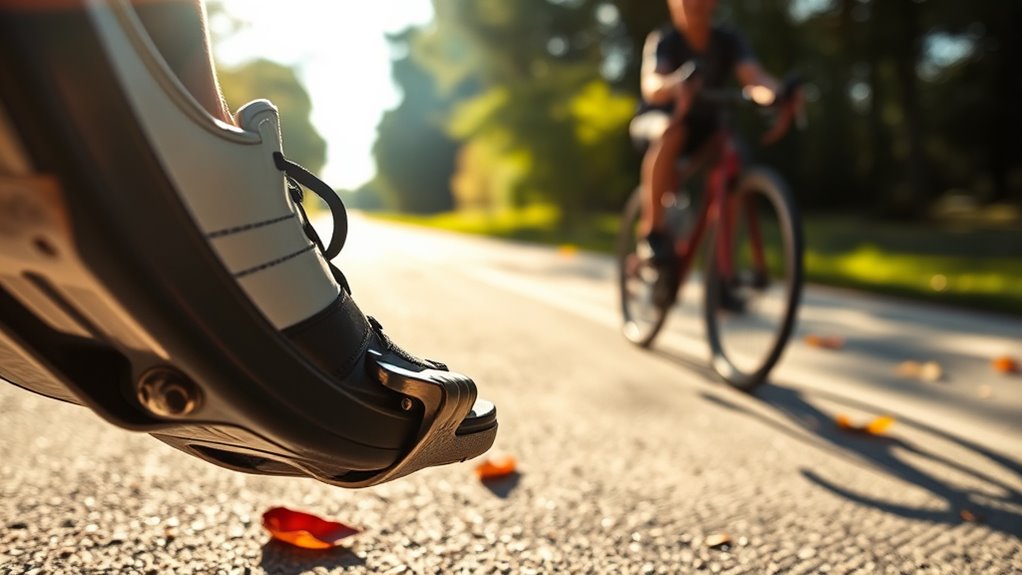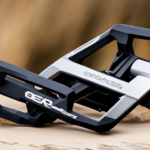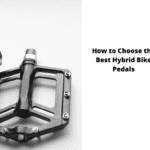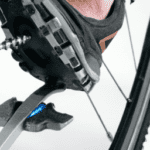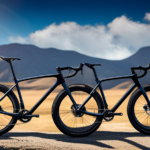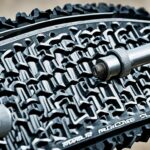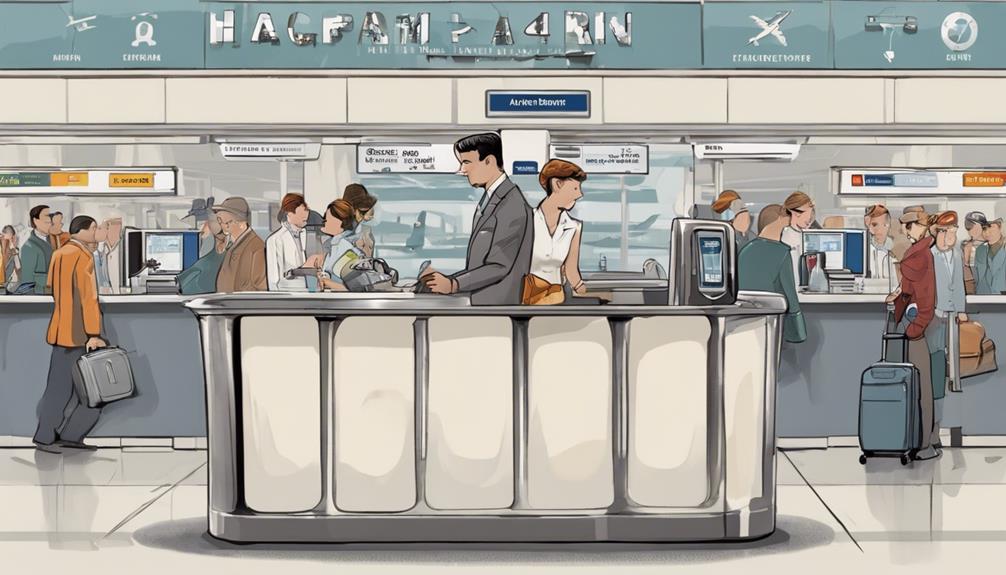Clipless pedals offer some great benefits for beginners, like enhanced power transfer and improved cycling efficiency, which can boost your performance. However, there’s a learning curve that might lead to falls, and you’ll need specific shoes that can be costly. These pedals provide better stability and control, but if you’re not careful, they might hinder your balance development. If you want to know more about maneuvering these pros and cons, keep exploring further.
Key Takeaways
- Clipless pedals enhance power transfer, improving efficiency and reducing fatigue during rides, making them advantageous for performance-oriented beginners.
- The secure attachment of clipless pedals prevents slips and allows for better bike control, particularly beneficial during intense rides.
- Beginners may face a learning curve with engagement and disengagement, leading to potential falls and requiring practice in safe environments.
- Specialized cycling shoes needed for clipless pedals can add to overall costs and may cause discomfort during long rides.
- Familiarity with routes and smooth pedaling can help beginners build confidence, while starting with flat pedals can aid in skill development.
What Are Clipless Pedals?
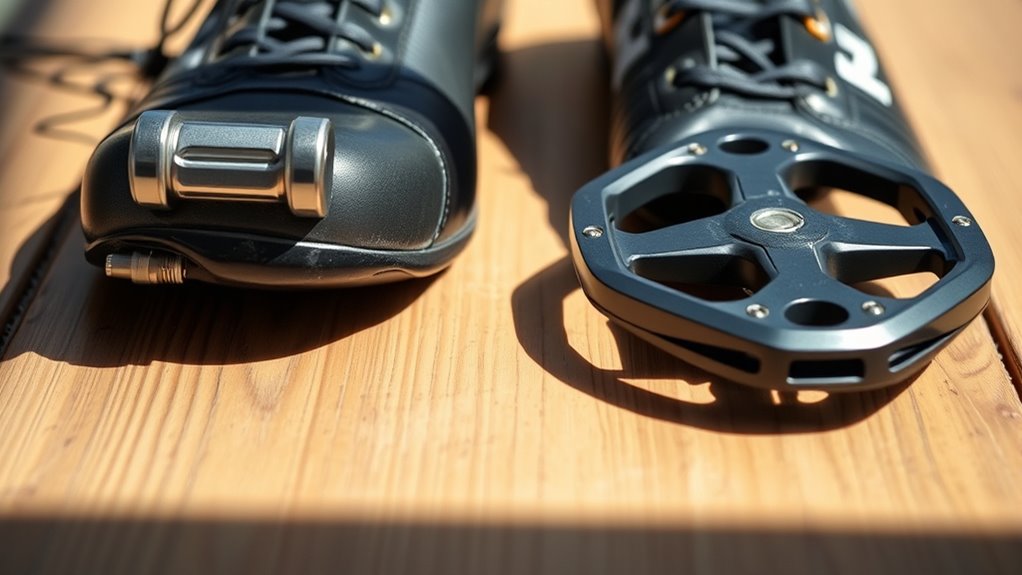
Clipless pedals are a game-changer for cyclists looking to enhance their riding experience.
These pedals securely attach to your cycling shoes using a cleat mechanism, allowing for improved power transfer and enhanced pedaling efficiency. Despite the name “clipless,” you’ll actually need a cleat that clips into the pedal, moving away from traditional toe clips and straps.
Clipless pedals attach to cycling shoes with a cleat mechanism, enhancing power transfer and pedaling efficiency for a superior ride.
This system lets you push down and pull up, optimizing your performance on both road and mountain biking. However, there’s a learning curve involved; you’ll need to practice the engagement and disengagement of the cleat to avoid falls and gain confidence.
Once you master it, clipless pedals can greatly elevate your cycling experience, especially as they provide enhanced power transfer that improves overall cycling performance.
Advantages of Clipless Pedals
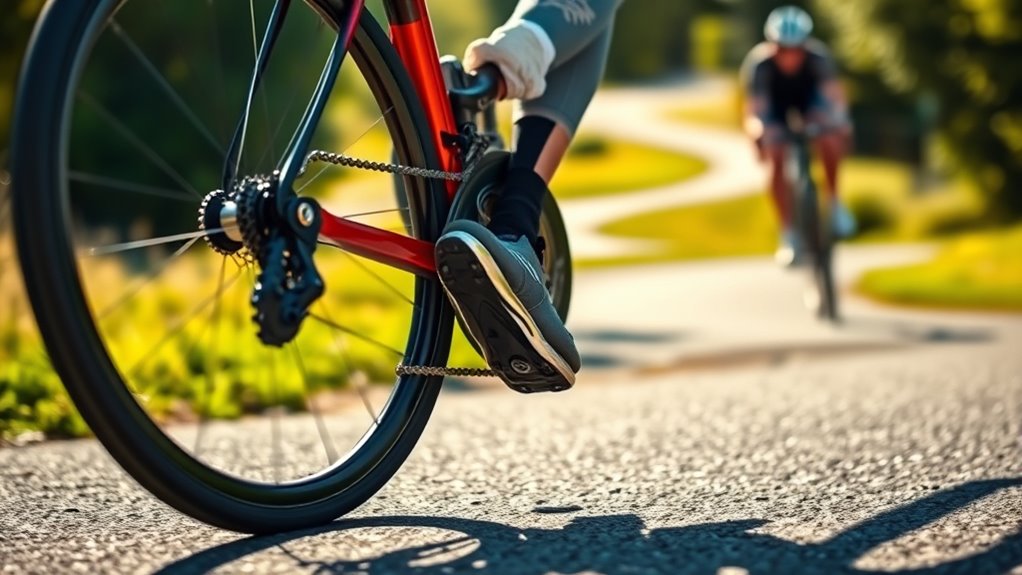
Using clipless pedals can greatly enhance your power transfer by allowing you to pull up as well as push down on the pedals. This connection not only boosts your efficiency but also improves stability and control, especially when maneuvering rough terrain. As you ride, you’ll likely notice how these advantages contribute to a smoother and more confident cycling experience. Additionally, just like having the right survival gear items can enhance your outdoor adventures, clipless pedals can significantly improve your cycling performance.
Enhanced Power Transfer
When you switch to clipless pedals, you’ll notice a significant improvement in your power transfer while cycling. These pedals allow you to push down and pull up, creating an efficient pedal stroke that maximizes your output. Research shows that you can achieve up to a 16.6% increase in power during sprints. This enhanced power transfer is further supported by stiff-soled cycling shoes, which minimize energy loss and guarantee a direct connection to the bike. Additionally, using clipless pedals can enhance your performance on gravel roads due to improved stability and control. The table below summarizes the key benefits:
| Feature | Benefit |
|---|---|
| Enhanced Power Transfer | Up to 16.6% more power |
| Efficient Pedal Stroke | Reduces fatigue |
| Direct Connection | Improved energy use |
| Stiff-Soled Cycling Shoes | Better stability and control |
| Overall Performance | Increases endurance |
Increased Stability and Control
As you ride with clipless pedals, you’ll discover a newfound level of stability and control that greatly enhances your cycling experience.
These pedals securely attach your foot, reducing slips during vigorous pedaling or on rough mountain biking trails. You’ll notice improved bike control as you can pull up on the pedals, providing better stability throughout your pedal stroke—especially during climbs and technical sections.
This connection allows you to focus less on foot placement and more on your riding technique. Plus, studies show that cyclists using clipless pedals can achieve a 16.6% increase in power output during sprints, further boosting your overall control and performance. For beginners, this means a more confident and enjoyable ride. Additionally, optimal comfort can significantly improve your overall cycling experience, making long rides more enjoyable.
Disadvantages of Clipless Pedals
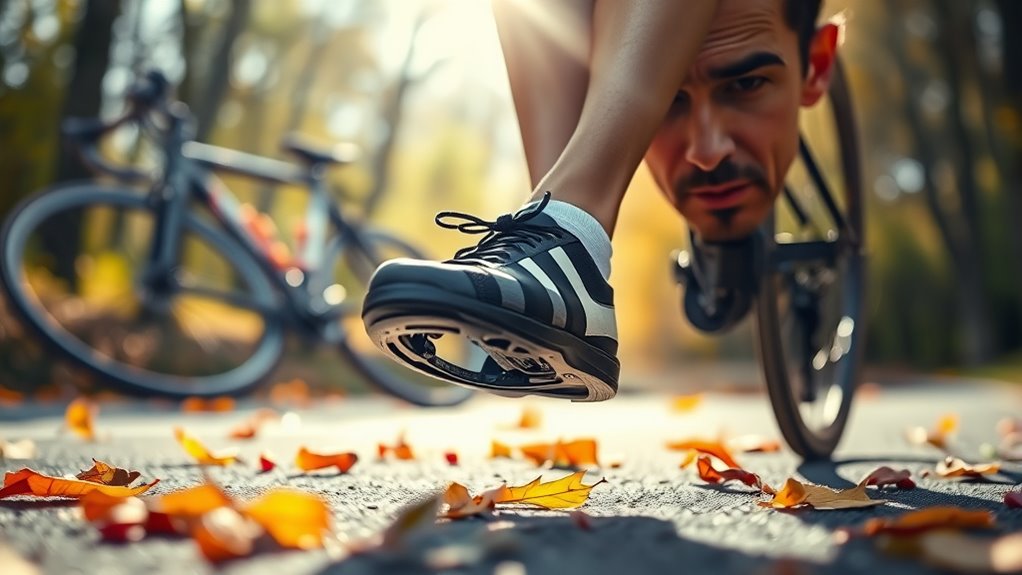
While clipless pedals offer advantages, they also come with some real challenges for beginners.
You might struggle with the learning curve and risk falls if you can’t unclip quickly in a pinch.
Plus, investing in specialized cycling shoes adds to your overall costs, making it a significant commitment. Additionally, having strong communication skills can help you navigate group rides and enhance your cycling experience through collaboration and support.
Learning Curve Challenges
Engaging and disengaging from clipless pedals can be intimidating for beginners, often leading to falls if you can’t unclip quickly in emergencies. The learning curve may feel steep, as you’ll need to practice in controlled environments before gaining confidence on the road.
Many beginners also experience discomfort in the ball of the foot due to concentrated pressure from clipless systems, particularly during longer rides. Plus, the specific cycling shoes required for clipless pedals can add to your expenses, and you’ll have to guarantee proper cleat adjustments to avoid pain.
Additionally, relying on clipped-in feet might hinder your ability to develop balance and riding techniques, which are more easily achieved with flat pedals. Regular maintenance of your cycling shoes can help mitigate some discomfort and improve your overall riding experience.
Risk of Falls
The risk of falls is a significant concern when shifting to clipless pedals, especially for beginners who may struggle to unclip quickly during stops.
New riders often face a steep learning curve, making it challenging to engage and disengage effectively. This difficulty increases the safety risk, particularly in emergencies or crowded settings where immediate stopping is required.
The incidence of falls tends to be higher among inexperienced cyclists using clipless pedals compared to those on flat pedals.
To mitigate this risk, practice in controlled environments is essential. Additionally, choosing clipless systems with adjustable tension settings can help beginners disengage more easily, ultimately enhancing their confidence and safety on the road. Understanding the importance of planning ahead can also help beginners prepare for potential risks associated with cycling.
Specialized Shoe Requirement
One of the notable challenges of using clipless pedals is the need for specialized cycling shoes that work with the pedal system. These compatible shoes often require a financial investment, which might deter beginners.
Plus, most clipless shoes feature stiff soles designed for efficient power transfer, making walking difficult and uncomfortable when you need to dismount.
The variety of clipless pedal systems, like SPD or Look, means you must choose shoes that match your pedals, adding complexity to your purchase.
Additionally, you might experience initial discomfort while adjusting to these shoes, which can hinder your cycling experience. Until you acclimate to the changes, this adjustment period can make fully embracing cycling a bit challenging. Moreover, the investment in specialized cycling shoes can be comparable to the costs associated with adopting a healthier diet, such as a vegetarian lifestyle, which also emphasizes the importance of proper nutrition.
How Clipless Pedals Work
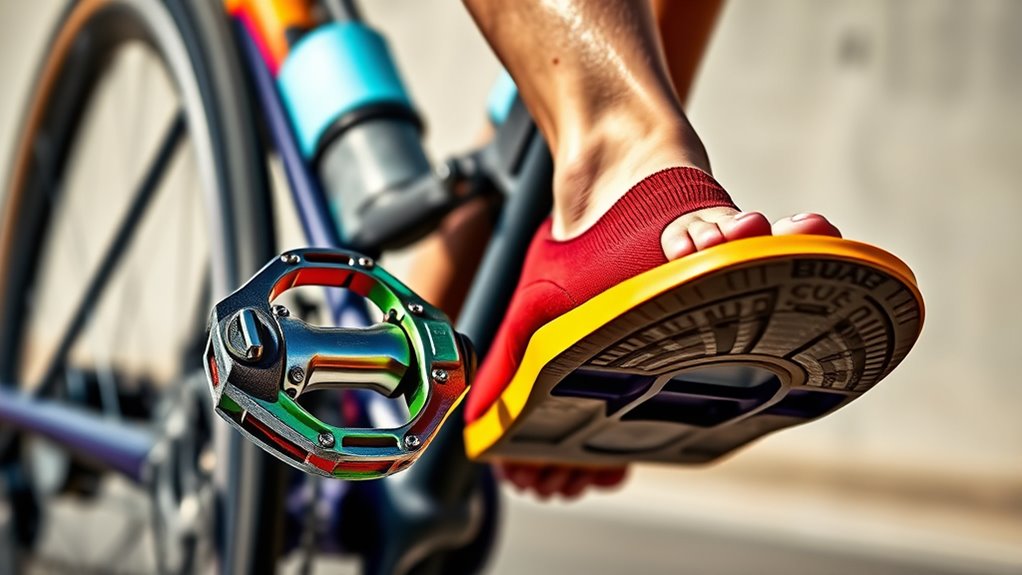
While you might think clipless pedals are a complex piece of equipment, their functionality is quite straightforward. These pedals use a cleat-and-pedal mechanism, allowing your shoes to securely attach, enhancing your ability to apply power efficiently. When clipped in, you can push down and pull up during your pedal stroke, improving cycling efficiency. The SPD system, designed for various riding styles, guarantees ideal engagement and disengagement. Proper cleat alignment and float settings are essential to maximize comfort and prevent knee pain. Additionally, using LED lighting around your cycling area can enhance visibility during early morning or late evening rides.
| Feature | Description |
|---|---|
| Mechanism | Cleat and pedal connection |
| Power Transfer | Improves cycling efficiency |
| Types | SPD for mountain, SPD-SL for road |
| Engagement | Quick and secure |
| Comfort Adjustment | Prevents knee pain |
Choosing the Right Clipless Pedals

Understanding how clipless pedals enhance your cycling performance sets the stage for making an informed choice.
First, consider your riding style: if you’re into road biking, opt for road bike pedals that prioritize speed and efficiency. For mountain biking, choose mountain bike pedals that offer more float and easier disengagement for varied terrains.
Guarantee compatibility with your cycling shoes by selecting pedals that match the cleat system, like SPD for mountain biking or SPD-SL for road cycling.
Look for adjustable tension settings on clipless pedals, which make engagement easier for beginners.
Finally, check the availability of spare parts, as popular systems like Shimano SPD offer replacements, guaranteeing your pedals remain in peak condition for long-term performance. Additionally, understanding state tax implications can help you budget more effectively for your cycling investments and retirement planning.
Getting Started With Clipless Pedals
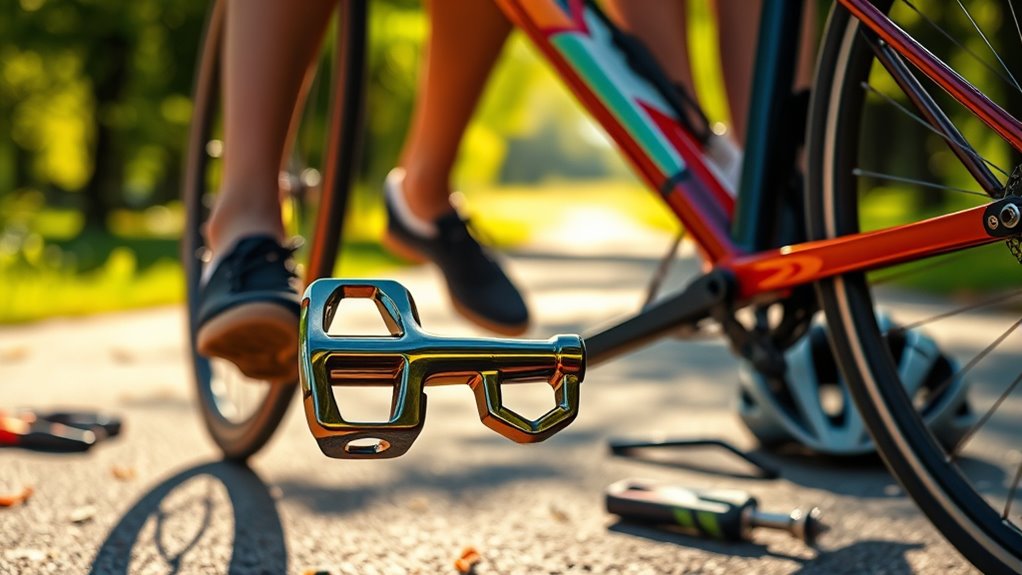
Getting started with clipless pedals can be a game changer for your cycling experience, as long as you take the time to familiarize yourself with the system.
First, choose compatible cycling shoes designed for your pedal system to enhance comfort and performance.
Next, practice clipping in and out of the pedals in a controlled environment. This helps build confidence before hitting the road or trails.
While riding, focus on smooth pedaling and maintaining balance, which will make the adjustment easier.
Remember to anticipate stops by planning to unclip before reaching intersections to avoid accidents.
Spending time on familiar routes will boost your comfort level and help you feel more natural while pedaling with clipless pedals.
Are Clipless Pedals Right for Beginners?
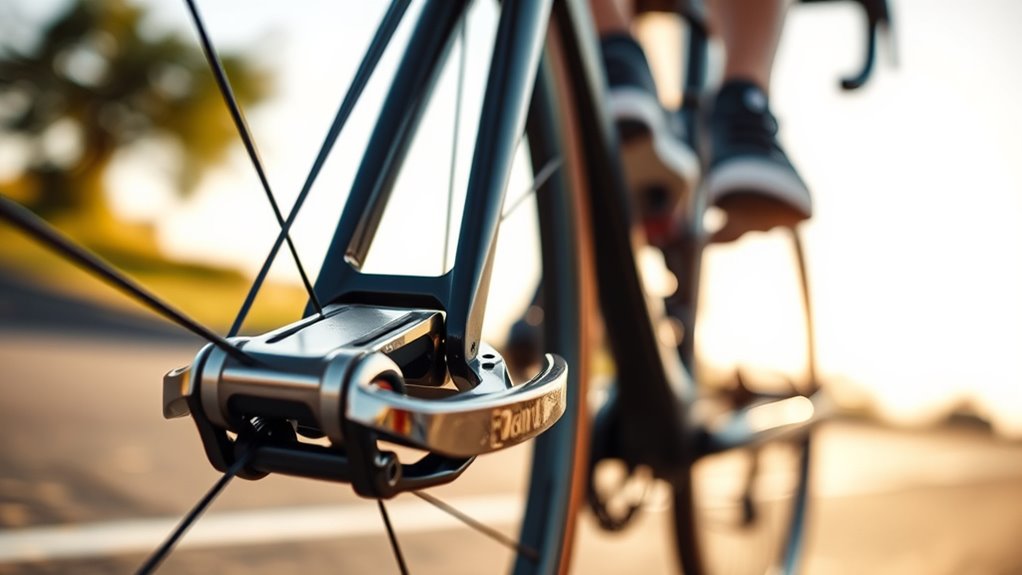
Are clipless pedals the right choice for beginners? While they offer enhanced power transfer and efficiency, especially for road cycling, beginners often face a steep learning curve.
Mastering how to clip in and out can lead to falls if you’re not careful. You’ll need specific cycling shoes to use clipless pedals, which can increase your initial costs compared to traditional flat pedals.
Learning to clip in and out takes practice and can lead to falls, plus you’ll need special shoes, adding to costs.
Although they provide better stability and control, quick stops can become tricky, making them less ideal for those still building confidence.
Many cycling coaches recommend starting with flat pedals to develop essential riding techniques before moving to clipless pedals for improved performance as your skills advance.
Weigh the pros and cons carefully before making your decision.
Frequently Asked Questions
Should Beginners Use Clipless Pedals?
You might want to hold off on using clipless pedals as a beginner.
They can be tricky to engage and disengage, which may lead to falls, especially in emergencies. It takes time to get comfortable clipping in and out, and that learning curve can shake your confidence.
Starting with flat pedals helps you build foundational skills.
Once you’re more experienced, shifting to clipless pedals could enhance your efficiency and performance.
What Is the Disadvantage of Clipless Pedals?
You might think clipless pedals are the ultimate cycling upgrade, but they come with disadvantages.
To begin with, there’s a steep learning curve; if you can’t unclip quickly, you risk falling. Plus, the rigid soles of cycling shoes can cause discomfort, especially if you’re not used to them.
Finally, maintaining the system and replacing worn-out cleats adds to your costs, making it essential to weigh these factors before committing to clipless pedals.
Is It Worth Switching to Clipless Pedals?
Switching to clipless pedals can definitely enhance your cycling experience, especially if you’re looking for improved power and efficiency.
You’ll notice better control and stability while riding, which can make a big difference in performance.
However, it’s important to take into account the learning curve and initial costs.
If you’re confident in your cycling skills and ready to invest in the right gear, it might be worth making the switch for serious rides.
How Hard Is It to Learn Clipless Pedals?
Learning clipless pedals can be challenging at first, but with practice, you’ll get the hang of it.
Start in a flat, open area to build your confidence. Adjust the tension settings to make clipping in and out easier.
Anticipate stops and unclip well in advance to avoid accidents. As you become more familiar with the mechanics, you’ll find that consistent practice leads to improved proficiency and a more enjoyable cycling experience.
Conclusion
To sum up, clipless pedals can enhance your cycling experience, offering improved power transfer and stability. However, the learning curve and potential for falls might make you hesitate. Are you ready to embrace the challenge and reap the benefits? If you choose the right pedals and take your time to adapt, you might find they elevate your rides to a whole new level. Ultimately, it’s about what feels best for you and your cycling journey.
